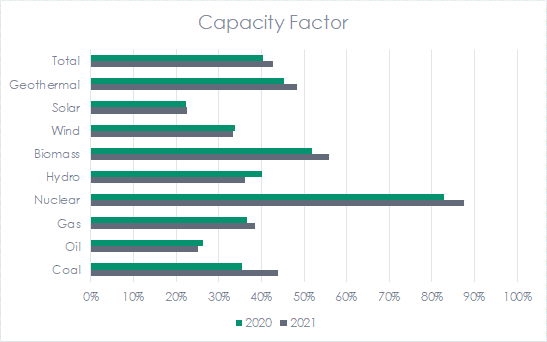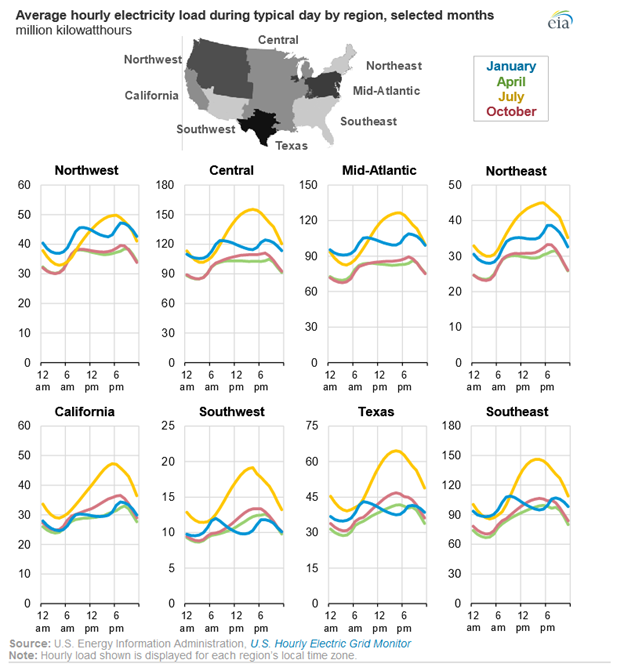
Washington Post headline last week: “World is on brink of catastrophic warming, U.N. climate change report says.” Wolf! Wolf!
People aren’t serious about decarb, and this post will prove it, but I provide ways to get it done.
Is Solar Plus Storage Competitive?
Solar is nice, but the numbers are ugly. If solar and storage with batteries were a serious contender for a clean energy grid, electric utilities would be soiling themselves because solar and batteries would put them out of business as customers would install their own and cut the cord.
Let’s look at some basic arithmetic.
Lazard pegs the levelized cost of utility-scale solar at about $35 per MWh or 3.5 cents per kWh. A 4-hour 50 MW battery runs $230 per MWh. This is already 26.5 cents per kWh together. I’ll come back to this.
The chart below features capacity factors computed from the most recent eGrid dataset for 2021. The capacity factor equals the energy a generator produces during a year divided by the maximum energy it could produce if it ran at nameplate capacity 24/7. We see the major dispatchable resources all increased in 2021 coming out of covid. The only variables for wind and solar are where they are located (e.g., Arizona v Minnesota) and curtailment for over-generation.

The capacity factor of solar is only 22%. Therefore, to displace nuclear power, which runs full tilt 24/7, we would need more than four times the nameplate capacity to jam enough electricity into 4.7 batteries[1]. Therefore, to displace nuclear, we have:
![]()
Plus
![]()
Gives $1.24 per kWh of 24/7 solar power using batteries. I’ve always said and maintained that the levelized cost of solar and batteries is irrelevant. What is the cost of having it when we need it around the clock?
As estimated by Lazard, the middle-of-the-cost range for new nuclear-generated electricity is $0.1675 per kWh. Rounding, seventeen cents for nuclear versus a buck twenty-two for solar and batteries. It is absurd to say solar plus batteries are competitive with thermal power plants, like nuclear.
Moreover, solar requires 10 acres per MW. The land needed to displace one nuclear power plant (1 GW) running 24/7 would be 40,000 acres, or 62 square miles, almost eight miles by eight miles.
Baseload Power
But wait, who needs 24/7 power? We do, and a lot of it. Applying mathematical jujitsu on the EIA data provided in the following chart, I have an average base load of 52% of peak load. Demand on the grid never falls below 50% of the summer peak, including in the middle of the night, spring or fall. At least 80% of that should be provided by 24/7 nuclear power. I don’t have the data, only my eyes on the curves below, but 80% of the baseload is probably 70% of all generated and delivered kWh.
I will pile on more for nuclear power. Does Lazard account for the fact that our nuclear fleet can operate for 60 years? People: your grade school children will be retired before Vogtle 3 and 4 are shut down!
Does Lazard factor curtailment of renewables because they already produce excessive power at times? Curtailment of wind generation reached 5% in the Midcontinent Independent System Operator footprint, and in some states is already around 13%[2].
Quick, Be Afraid!
Why are we not pursuing zero-carbon nuclear power? 1) no one is doing the math like above, and 2) fear porn.
March 19, 2023, a headline from the revered NPR: “A nuclear power plant leaked contaminated water in Minnesota.” The NPR reported contamination referred to tritium. Tritium is an isotope of hydrogen, meaning it carries a couple of extra neutrons. The tritium is bound with oxygen in a water molecule. It is so lethal (snark alert) that the nuclear regulatory commission doesn’t even require that a release to the environment needs to be reported. Tritium is a natural isotope found in nature and it has a 12-year half-life. Upon decay, it emits beta particle that is too weak to penetrate the skin. When ingested, it passes through the body with other water and out through the kidneys. All those glow sticks at the teeny-bopper concert are powered by tritium. It’s lethal.
Why Are Utilities on Board?
Why are utilities building utility-scale solar, wind, and batteries? 1) They must play in the game established by naïve lawmakers and the public in general, and 2) archaic regulation that rewards building things rather than operating at the lowest possible cost.
Rookies are Expensive
The Vogtle plants cost twice the original estimate, but that happens when commercial-scale power plants are built once in two generations or once per 40-year career. Try fielding a team in the NFL made up of nothing but rookies. How is that team going to fare? It’s the same situation. Scale and repetition would bring nuclear power back in line with estimates.
No Scale
Last week, TVA and GE Hitachi announced they committed $400 million to an international small modular reactor. If that were money lying on the street in a crosswalk for R&D startups, it wouldn’t be worth bending over to pick it up. Last week Ford announced it would lose $6 billion on its EV development efforts from 2021-2023. That is an investment for scale. Four hundred million is a nice grant for a university to conduct research. There is no serious investment in serious carbon-free electricity.
I have more choices being made to reject the climate rescue coming next week.
[1] 0.78 (i.e., 100% minus 22% capacity factor) times 24 hours divided by 4 hours per battery.
[2] Credible source, believe me.

